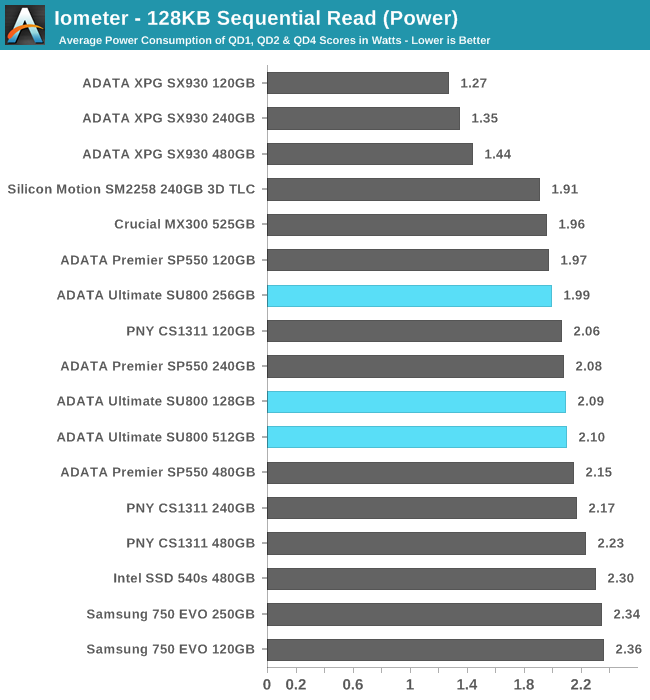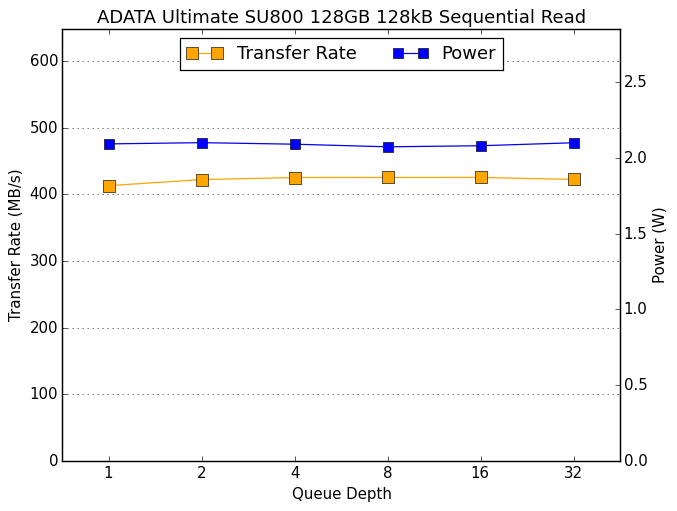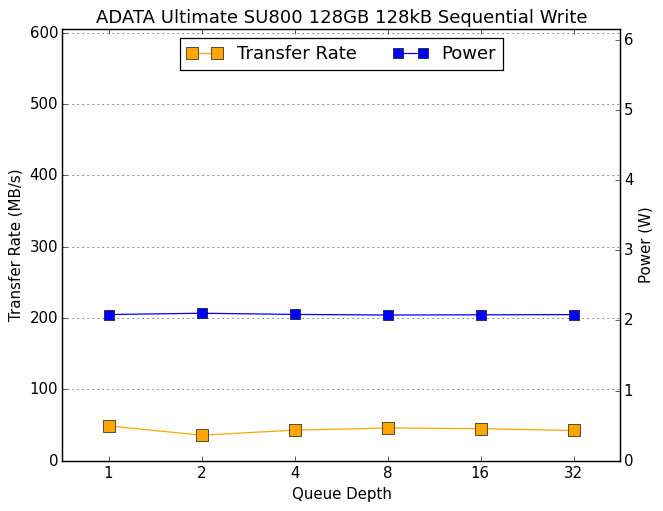The ADATA Ultimate SU800 SSD Review (128GB, 256GB, 512GB)
by Billy Tallis on February 1, 2017 12:01 PM ESTSequential Read Performance
The sequential read test requests 128kB blocks and tests queue depths ranging from 1 to 32. The queue depth is doubled every three minutes, for a total test duration of 18 minutes. The test spans the entire drive, and the drive is filled before the test begins. The primary score we report is an average of performances at queue depths 1, 2 and 4, as client usage typically consists mostly of low queue depth operations.

The smallest capacity of the ADATA SU800 has the slowest sequential read speed of all the drives in this comparison, as it only has flash connected to three of the controller's four channels. The larger SU800s saturate the SATA connection.

The SU800's power consumption is middle of the road for TLC drives, giving the larger two capacities slightly better than average efficiency. The ADATA XPG SX930 demonstrates that MLC NAND flash still has a significant efficiency advantage.
 |
|||||||||
The larger two capacities of the SU800 show modest performance improvement across the first half of the test, while the 128GB model exhibits almost no scaling.
Sequential Write Performance
The sequential write test writes 128kB blocks and tests queue depths ranging from 1 to 32. The queue depth is doubled every three minutes, for a total test duration of 18 minutes. The test spans the entire drive, and the drive is filled before the test begins. The primary score we report is an average of performances at queue depths 1, 2 and 4, as client usage typically consists mostly of low queue depth operations.

The sustained sequential write speeds of the SU800 are quite poor, but this is no surprise after seeing how much a full drive hurt performance on the ATSB Heavy and Light tests.

Power consumption is at least better than average, so the SU800 isn't too far behind the average for efficiency.
 |
|||||||||
Aside from the initial effects of filling up the SLC cache, performance and power consumption during sequential writes don't scale with queue depth on the SU800.










35 Comments
View All Comments
Arbie - Thursday, February 2, 2017 - link
@eek2121: Anandtech has changed most of its drive tests in the past two years, but it's easy to compare the Mushkin Reactor to this Adata in IOMeter 4KB random reads & writes. In these, the Mushkin is 50% faster. So please provide your basis for saying it's "drastically slower". While it may "soon disappear", that's been true for the past 18 months and it's still there, at $240. And FYI "clickbait" is the swathe of pandering pix labeled "From the Web". Anandtech provides these to raise its status as a on-line source of repute and save us the trouble of looking for garbage on our own.Billy Tallis - Thursday, February 2, 2017 - link
The Mushkin Reactor was one of the last drives tested with our 2013 test suite. Even though we used IOmeter back then, the test protocol was different. The 4kB random access numbers reported in that review were for QD3 using an 8GB test file, while our current 2015 test suite uses a 16GB file for random writes and the whole drive for random reads, and the score reported is the average of QD1, QD2, and QD4 performance. If the numbers were directly comparable, we'd be directly comparing them.TheinsanegamerN - Thursday, February 9, 2017 - link
"drastically"A few thousand IOPS is "drastically" now eh? For this market, they would never notice the difference.
eek2121 - Wednesday, February 1, 2017 - link
What is so click-baity about this? It's a review. Did you bother reading it? They came to the same conclusion you did. It's not that great. The Mushkin Reactor has been discontinued, why would they include it?lopri - Thursday, February 2, 2017 - link
That drive is not faster than what is benched. MLC does not automatically make a good SSD.Having said that, I do sometimes think AT neglect hardware of the past in their review, which is regrettable. Consumers not only compare current products but also upgrade their old gears, and they want to see if it is a worthy undertaking.
fanofanand - Wednesday, February 1, 2017 - link
Some might say I am being greedy or unrealistic, but I think that when SSD's hit 1TB for under $100, then we will finally be able to put the axe in mechanical hard drives with the exception of the 10+ TB drives for archiving or media libraries. If I could pick up a 2TB for under $200 I would buy it today. We are so close, yet so far.Great_Scott - Wednesday, February 1, 2017 - link
1TB drives were around $200 6 months ago.Most people seem to have around 3TB of data, not including any bloated Steam libraries, $600 over the course of a year (late 2015 to late 2016) seems reasonable, it's what I did.
Of course, the recent price increase probably blindsided most people, but if it was made a priority many enthusiasts don't need to be using spinning rust pretty much regardless of non-archive non-media (bulk) data.
But I keep seeing posts like yours. Does everyone want to only use 1 SSD in thier PC for some reason?
Laststop311 - Wednesday, February 1, 2017 - link
You have to not include blu ray disc image libraries either. I have a 6 bay NAS with 6x 4TB in raid 5 giving me 20TB of space 10TB of that is gone from 200 blu ray disc images and another 5TB from FLAC audio. When I have to upgrade all my disc images to 4k blu ray disc images they double in size + i will have more fo them. I will have to rebuild my nas with 6x 12TB drives at that point. So plenty of enthusiasts will still need spinning rust. For my next PC tho I plan on using a 128-256GB optane drive for the OS and most used productivity apps and VLC media player and chrome and my favorite couple games. A 1TB nvme drive for the majority of my most played games and 2x 2TB SATA 3 2.5" SSD's that my torrents will download onto and seed for awhile before being moved to the NAS or installed on a faster drive or deleted.The_Assimilator - Thursday, February 2, 2017 - link
"Does everyone want to only use 1 SSD in thier PC for some reason?"Why use a whole bunch of drives if you can only use 1? Saves on cable clutter, physical space (important for the rise in SFF systems) and just makes things simpler overall. Personally I can't wait for 4TB SSDs to become mainstream in price so that I can replace my mechanical disk.
JimmiG - Thursday, February 2, 2017 - link
I have about 1.2 TB of SSD storage spread over 240 GB, 480 GB and 500 GB SSD's, bought in the last couple of years. 1.2 TB in a single drive would be much more convenient since you wouldn't have to juggle your game installations and other files to keep the amount of free space on each SSD reasonable and balanced.After I got a NAS, I only have an old 1 TB HDD (in addition to the SSDs) in my PC for general data storage and less frequently used applications and games. I don't think "spinning rust" is going anywhere, but I think the smaller capacities (<3TB) are going away. People want them for bulk storage in NAS devices or as external USB drives.